Budget Magic: $25 (3 tix) Standard Eldrazi Aggro
Howdy Budget Magic lovers! It's that time again. This week we are heading back to Battle for Zendikar Standard to play the oxymoronic sounding Eldrazi Aggro. The best part about this deck is that it is incredibly cheap: $26 in paper or only 3 tix on Magic Online. If you are looking for an ultra budget option to the very expensive Battle for Zendikar Standard, this might be the deck for you. While it may never be tier one (although who knows what Oath of the Gatewatch brings this winter), it does have a lot going for it and can generally compete with the most expensive decks in the format, thanks in no small part to Ghostfire Blade. Plus who wouldn't want to sleeve up a deck with 29 Eldrazi?
We'll break down the deck in a minute, but first let's get to the videos. Oh, a quick reminder: if you enjoy the Budget Magic series and the other video content on MTGGoldfish, make sure to subscribe to the MTGGoldfish Youtube Channel to keep up on all the latest and greatest.
Eldrazi Exile Intro
$25 Eldrazi Aggro vs Jeskai
$25 Eldrazi Aggro vs Five-Color Control

While the deck was moderately successful, I realized two cards in particular were too high variance for my liking. The first was Swarm Surge, which is powerful in the right situation (when you are trying to attack through a gummed up board) but really bad when you are behind. My perception might have been tainted by the fact that we drew an insane number of Swarm Surges in our games, but I decided it had to go.
The second suspect card was Titan's Presence. You'll see Titan's Presence in the videos, but I've already cut it from the list for some Roasts. Unlike last week's Ulamog Exile deck where we had a bunch of expensive creatures sitting in our hand, in Eldrazi Aggro our goal is to empty our hand as quickly as possible. Titan's Presence is also an extremely bad top deck. There were a bunch of situations where I wanted to draw any non-land card in our deck — except for Titan's Presence. It was enough to make me want a more consistent removal spell in this slot.
Finally, in the couple of games I played before recording, I often felt we were one spell/turn away from winning a game. As a result, I really wanted to add some reach to the deck; cards that, when our midrange or control opponents stabilize, could still push through the final points of damage. As a result I ended with a slightly more expensive ($57 in paper, 9 tix online) version of Eldrazi Aggro that takes advantage of our Red mana to play some burn spells that can also finish the game.
$56 Eldrazi Aggro vs the Aristocrats
$56 Eldrazi Aggro vs Jeskai Black

As you can see I actually did better with the less expensive version, but I still think adding Exquisite Firecraft and Wild Slash over Swarm Surge and Titan's Presence was the right call. The deck still runs into trouble when the game goes late. If our opponent gets to the point where he or she can just one-for-one all of our creatures, we are left hoping to draw enough burn spells to finish the game, which doesn't always work out. More often than any other deck I've played recently, Eldrazi Aggro feels like it is one turn away from winning when the opponent stabilizes and puts the game out of reach with a flurry of removal spells or multiple Siege Rhinos. This said, the deck is still reasonable — especially when you consider its cost.
The Cards

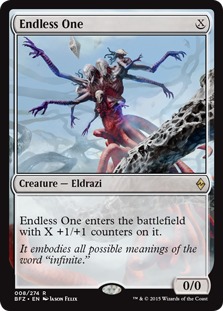
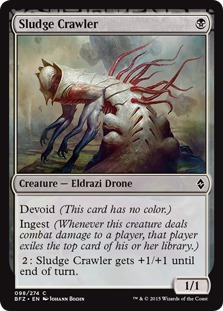
Ghostfire Blade is the reason to play Eldrazi Aggro. Our easiest path to victory is to attack with one of our colorless one-drops on turn two equipped with Ghostfire Blade. In some sense, Eldrazi Aggro plays like the UR Ensoul Artifact deck that was popular last summer. Although we don't get Ensoul Artifact or Shrapnel Blast, the idea is the same: play some janky colorless creatures and turn them into huge threats with Ghostfire Blade.
I'm really torn on whether Sludge Crawler or Endless One is the better one-drop in this build. The advantage of Sludge Crawler is that when equipped with Ghostfire Blade, you can use the threat of its pump ability to attack through a Siege Rhino on turn four, which is a big deal. So on turn one, Sludge Crawler is always the better play. On the other hand, Endless One provides some protection for flooding out. While we will always play it as a 1/1 on turn one if we have Ghostfire Blade in hand, sometimes it is a 4/4 for four or a 6/6 for six. While it's never above the curve, Endless One's ability to always be on curve makes it a strong card, especially in a deck built around colorless synergies.
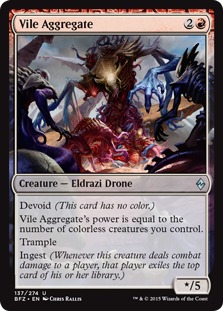
Vile Aggregate is one of the more powerful cards in our deck. At worse it blocks anything for three-mana. At best Vile Aggregate ends up being a massive attacker, busting through anything in its path. With Ghostfire Blade and a few colorless creatures, I've actually attacked through Dragonlord Atarka. Plus having trample makes life miserable for opponents, often forcing unprofitable chump blocks. While it might sound silly, Vile Aggregate is basically the Tarmogoyf of Eldrazi Aggro. Apart from Ghostfire Blade, it's the card you most want to see in your opening hand.
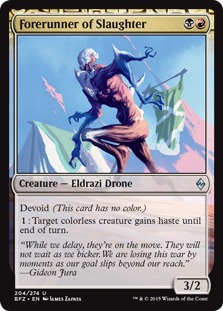

While a 3/2 on turn two is slightly above curve, the real beauty of Forerunner of Slaughter is its ability to give every creature (including itself) in our deck haste. This allows us to play Forerunner of Slaughter as a hasty three-drop. In later turns, giving a Vile Aggregate haste can allow us to win the game out of nowhere.
Wasteland Strangler isn't as exciting in this deck as in Ulamog Exile because our ability to ingest cards is inconsistent. This said, it's perfectly acceptable to play a Wasteland Strangler without using its Flametongue Kavu ability simply to keep pressure on our opponent.
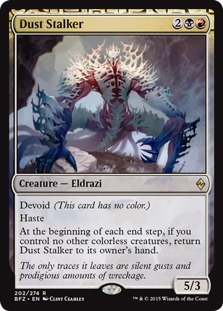
Dust Stalker is our finisher. It ranges from extremely strong (when our opponent has an empty board) to relatively tame (when our opponent can block with something like a flipped Den Protector). One thing I realized while playing these matches is that the drawback of returning Dust Stalker to our hand is often an upside. It gets around the +1 of Jace, Vryn's Prodigy, dodges sorcery speed removal like Ruinous Path, and sometimes kills a planeswalker (or our opponent) out of nowhere if they are unprepared.
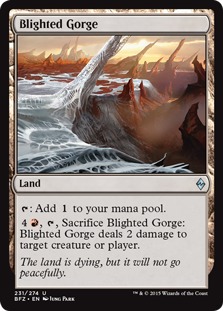
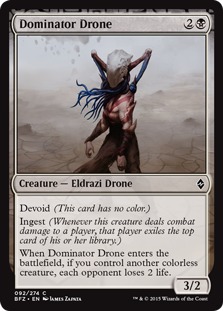
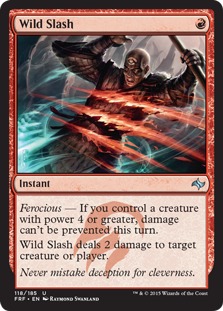

As I mentioned earlier, our deck is really good at getting early damage in, but sometimes fizzles once our opponents unleash torrents of removal spells or multiple copies of Siege Rhino. Some combination of these reach spells should help shore up this problem. Personally, I like the build with more reach better, but I actually had more success with the cheaper, less reach version. One thing I'm sure of: the inexpensive version should not play Titan's Presence. Its inclusion in the original was a mistake on my part. Any other removal spell, from Ultimate Price to Roast to Exquisite Firecraft to Murderous Cut, is better in this slot. I repeat, don't play Titan's Presence!
Non-Budget Eldrazi Aggro
Due to popular demand for upgraded versions of Budget Magic decks, I'm going to start including a non-budget build at the end of every article. I might start making non-budget videos as well, but only for Budget Magic decks I really find appealing. As such, if I were to play Eldrazi Aggro at an SCG Open or Grand Prix, here's the deck I'd bring:

Conclusion
Anyway, that's all for today. I definitely recommend trying out the deck. Getting to play with 29 Eldrazi is fun. Although the deck isn't tier one, it is competitive enough to keep you in games. With good draws, Eldrazi Aggro can take down tier one Standard decks that cost twenty times more. I really think this deck's time to shine might be in the winter, assuming Oath of the Gatewatch offers more Eldrazi support. Or perhaps in the spring with Mr. Siege Rhino finally rotates from the format, along with the rest of Khans of Tarkir and Fate Reforged.
So what do you think of the deck? What improvements can be made? Did I miss any cards that would be great inclusions? As always, leave your thoughts, idea, and opinions in the comments. You can reach me on Twitter (or MTGO) @SaffronOlive.













